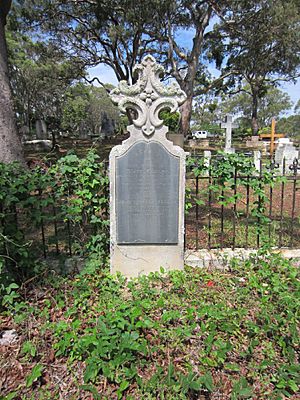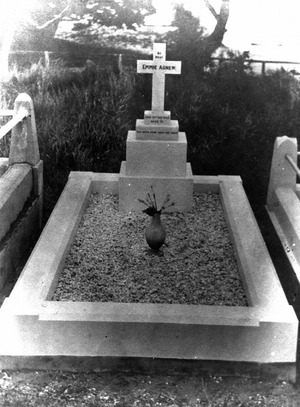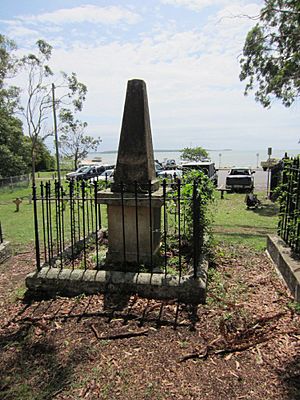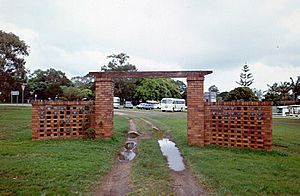Dunwich Cemetery facts for kids
Quick facts for kids Dunwich Cemetery |
|
|---|---|

Dunwich Cemetery, 2015
|
|
| Location | Bingle Road, Dunwich, North Stradbroke Island, City of Redland, Queensland, Australia |
| Design period | 1840s - 1860s (mid-19th century) |
| Built | 1847 - 1952 |
| Official name: Dunwich Cemetery, One Mile Cemetery | |
| Type | state heritage (built, archaeological) |
| Designated | 21 October 1992 |
| Reference no. | 600773 |
| Significant period | 1847- (social) 1847-1952 (historical, fabric) |
| Significant components | sarcophagus, memorial surrounds/railings, memorial - other, trees/plantings, memorial - obelisk, grave marker, cemetery |
| Lua error in Module:Location_map at line 420: attempt to index field 'wikibase' (a nil value). | |
Dunwich Cemetery is a special place on North Stradbroke Island in Queensland, Australia. It's a very old cemetery where people have been buried since 1847. It's also known as One Mile Cemetery. This historic site is important because it tells us a lot about Queensland's past.
Contents
The Story of Dunwich Cemetery
The Dunwich Cemetery is one of the oldest cemeteries still around in Queensland. People believe the first burials happened here in 1847.
Early Days on Stradbroke Island
European settlement on Stradbroke Island started in 1827. A small convict camp was set up at Dunwich. It helped the main convict settlement in Brisbane. But this camp didn't last long. It closed in 1831 because of bad weather, smuggling, and issues with local Aboriginal people.
Later, from 1843 to 1847, a Catholic mission tried to help Aboriginal people at Dunwich. It used the old convict buildings. But this mission also didn't succeed. The buildings were in poor condition. Also, the Aboriginal people on the island had already met many Europeans.
A Place for Quarantine
The government often used Dunwich because it was isolated. This made it good for health reasons. In 1841, rules for quarantine began in Australia. Quarantine means keeping sick people separate to stop diseases from spreading.
In 1850, Dunwich became a quarantine area. Some burials had already happened there. The first known burial was of sailors from a ship called Sovereign in 1847.
Just two months after the quarantine station opened, a ship named Emigrant arrived. Many passengers on board had typhus, a serious disease. The ship was sent to Dunwich. Sadly, 26 passengers died there. They were buried in the cemetery. The doctors who helped them, Dr David Keith Ballow and Dr George Mitchell, also died and were buried here.
The Benevolent Asylum
In 1867, the quarantine station moved to Peel Island. Dunwich then became the Dunwich Benevolent Asylum. This was a place for elderly, disabled, or sick people who had no one to support them. It was thought that keeping them on an island, away from the city, was the best way to care for them.
The Asylum also cared for people with various health conditions. For example, a special area for people with leprosy was set up nearby in 1892. It later moved to Peel Island in 1907.
Cemetery Closure and Restoration
The Dunwich Benevolent Asylum closed in 1947. The people living there moved to another home in Sandgate. Over 80 years, from 1867 to 1947, more than 8,400 people from the Asylum were buried in Dunwich Cemetery. Many of these graves were not marked. Some people buried there were also descendants of the traditional owners of Stradbroke Island.
The cemetery officially stopped new burials in 1952. Over time, it started to fall apart. Headstones were damaged or stolen. In 1970, the Redland Shire Council became responsible for the cemetery.
Restoration work began in 1987-1988. A special memorial wall was built using bricks from the old Asylum laundry. This wall honors all the people buried in unmarked graves. Names are added to it as they are discovered through research. In 1993, a metal sign was put up listing the names of the 26 immigrants from the Emigrant ship.
What You Can See at Dunwich Cemetery
Dunwich Cemetery is a large grassy area with many old trees. It looks out over Moreton Bay. The cemetery covers about 3.3 hectares (about 8 acres). It's believed to hold around 10,000 burials. Most of these are from the Benevolent Asylum and are unmarked.
Important Memorials
You can enter the cemetery from Flinders Avenue through a brick gateway. In one corner, you'll find several memorials. These include markers for the 26 passengers from the Emigrant ship. There's also a modern metal sign with all their names.
Nearby are the graves of Dr David Ballow and Dr George Mitchell. Dr Ballow's grave has a special stone coffin shape called a sarcophagus. Dr Mitchell's grave has a tall, pointed stone monument called an obelisk. Metal fences surround both. You can also see a memorial for Dr Patrick Smith, who was a medical leader at the Benevolent Institution for many years.
There's a triangular brick structure with nameplates. This is the memorial wall built from the old Asylum laundry bricks. It remembers those buried without marked graves. You'll also find other memorials scattered throughout the cemetery.
Why Dunwich Cemetery is Important
Dunwich Cemetery is listed on the Queensland Heritage Register. This means it's a very important historical site.
A Glimpse into History
The cemetery shows us how Queensland developed. It's one of the oldest cemeteries in the state. The burials from the 1850 typhus outbreak on the Emigrant ship show its early use as a quarantine station. The many burials from the Benevolent Asylum (1867-1946) tell us about how society cared for people in need during that time. It shows how people who were poor, elderly, sick, or disabled were often kept separate from the rest of society.
Connecting with the Past
The cemetery has a strong connection with the community of Stradbroke Island. It's especially meaningful to the families of those buried there.
Famous People Buried Here
- Alexandre Arsène Girault, a scientist who studied insects.




